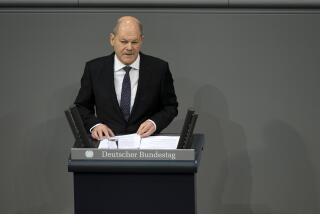GE, Pratt Signal Hope Beyond Budget Crisis
- Share via
In a week when sensible citizens despaired of politics and the federal budget, there was a ray of hope in the announcement by General Electric and the Pratt & Whitney division of United Technologies that they will collaborate on research into a new engine for a supersonic commercial airliner.
The news was hopeful because it looked ahead to the kind of technological progress that will carry the economy forward when the current budget politicking is long forgotten.
Not that the budget isn’t a serious matter. It is. The U.S. national debt has risen to more than 60% of the gross national product, and the budget deficit is more than 5% of GNP. Those are not unprecedented or astoundingly bad figures, but they are a limit--a level at which it is essential that steps be taken to reduce the deficit. And steps are being taken.
But it is essential also to look ahead. GE and Pratt & Whitney, the world’s largest jet engine makers, will do joint research in the next two years and then will almost certainly decide to collaborate on an eight-year engine development program costing $3 billion to $4.5 billion. The companies are joining forces, they have told the Justice Department, because of the project’s size and technical challenges.
Interestingly, those challenges are environmental. The biggest technical barriers that GE and Pratt & Whitney have to work on are noise and emissions. The proposed plane will fly, at twice the speed of sound, up near the ozone layer--so emissions must be severely limited. And the plane will have to land at conventional airports, so noise levels must not exceed today’s subsonic jets.
Meanwhile, the airframe companies, Boeing and McDonnell Douglas, are working on designs to minimize sonic booms.
The requirements are extremely demanding, which is why the companies will receive help from the National Aeronautics and Space Administration. NASA has $25 million this year and will have more than $40 million in the budget now being negotiated for high-speed plane research. The money is part of a six-year $300-million supersonic research effort “that will focus on environmental barriers,” says program director Robert Whitehead.
Fine, but why go forward now in a time of budget constraint? One reason is U.S. technology. The U.S. companies believe that they have found something in variable cycle engines that will enable them to meet the technical requirements.
And a big reason is that the competition is already moving. The European companies that built the supersonic Concorde 20 years ago have begun work on a faster, larger successor that they hope will carry enough passengers to be a commercial success, as the original Concorde has never been. Japanese companies and their government also are embarked on a supersonic plane project. All the supersonic builders are aiming at the rapidly growing Asia-Pacific market, where travel distances are tremendous. But the European and Japanese builders are aiming also at U.S. leadership of the global aircraft industry.
Therefore, it’s reassuring that the government is backing U.S. plane and engine makers with a small but significant budget priority.
It shows that some perspective is maintained amid all the politicking, such as last week’s distracting arguments over taxes on capital gains and high incomes. As President Bush acknowledged in proposing one tax compromise Thursday, the whole effort was a “waste of time” because Congress is extremely unlikely to pass a tax measure with three weeks to go before elections.
Taxes are not the real issue. Spending cuts are, and experts say they are meaningful. “This is a significant reduction package,” says Stanley Collender, director of budget policy for Price Waterhouse, the accounting firm.
The numbers may not seem impressive: Only $40 billion is to be cut in fiscal 1991--which began Oct. 1--from a total budget of $1.17 trillion, which would otherwise have a deficit of $292 billion. But that’s enough, says economist James Fralick, of the Morgan Stanley investment firm, because this cut is linked to a multi-year program to curb government outlays.
“If we can cut only $25 billion a year from the deficits, we’ll be all right,” Collender says.
Sensible citizens may be skeptical, especially after the political fumbles of the past week. But keep some perspective. For all the fear mongering about the budget, there is nothing unique about America’s deficit or the program to reduce it. Japan and many European nations have debt levels that are proportionately larger than the U.S. total, and budget deficits that are higher.
Japan, for example, ran very high deficits in the 1970s and early ‘80s. But then it set modest limits on government spending over a six-year period and slowly worked the deficits down--while economic growth picked up and Japan’s redoubtable industries pursued new technologies and markets.
Just so. Today the U.S. government is embarking on a similar program of spending limits--even as its redoubtable industries push on to new technologies that will produce future economic growth.
More to Read
Inside the business of entertainment
The Wide Shot brings you news, analysis and insights on everything from streaming wars to production — and what it all means for the future.
You may occasionally receive promotional content from the Los Angeles Times.










